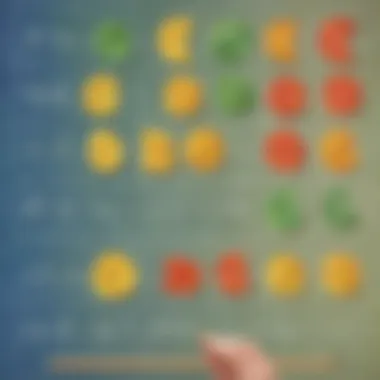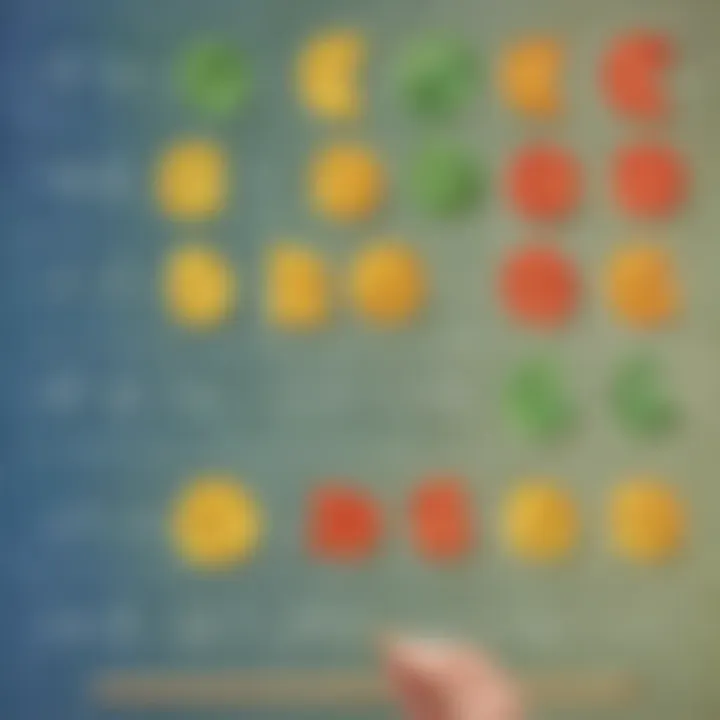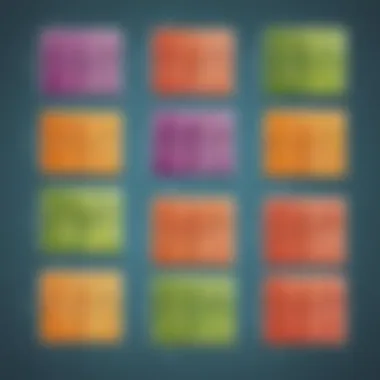Mastering Addition and Subtraction of Like Fractions


Intro
Navigating the world of fractions can feel like wandering in a maze without a map, especially for children. However, understanding how to add and subtract fractions with like denominators is a crucial stepping stone in their mathematical journey. This isn't just about numbers; it's about building a strong foundation that will support more complex math concepts down the line.
Imagine a scenario where two friends want to combine their slices of pizza. If one has 2/8 of a pizza and the other has 3/8, it’s a straightforward task to add them together. No fancy tricks required! In this guide, we’ll dig into these operations, addressing misconceptions, providing memorable examples, and giving parents and educators tools to make these lessons both clear and enjoyable for kids.
Let's gear up to explore an engaging method that combines learning with fun, ensuring that adding and subtracting fractions becomes second nature for young learners.
Interactive Learning Games
Games are more than just a way to pass the time; they can transform complex topics into simple, enjoyable experiences. When it comes to understanding fractions, interactive games serve a dual purpose: they reinforce mathematical skills while keeping students engaged. Here’s a closer look at some popular games and their benefits.
Popular Games
- Pizza Fraction Grade 3 by Education.com This game focuses on helping children understand fractions by manipulating pizza slices to create different combinations.
- Fraction Frenzy by SplashLearn This interactive platform offers a variety of fraction-related games that put competition into learning.
- Math Bingo Fractions by The Math Learning Center A unique take on Bingo where players solve fractions to complete their cards.
Description of Top Educational Games
Many of these games break fractions down into visuals. Take Pizza Fraction: kids see slices, which helps demystify the process of addition and subtraction. Fraction Frenzy urges players to solve problems quickly, creating a fun pressure that keeps them sharp.
Benefits of Playing Educational Games for Kids'
Cognitive Development
Playing educational games isn't merely about improving math skills. Here are some unexpected benefits:
- Enhances Problem-Solving Skills: Games require critical thinking to come up with strategies.
- Promotes Cooperative Learning: Many games encourage teamwork, helping children learn from one another.
- Builds Confidence: Success in games translates to an increase in mathematical confidence, which can carry over to other subjects.
"Education is not preparation for life; education is life itself." - John Dewey
Game Reviews
Understanding the gameplay and learning outcomes can help you choose the right games. For instance, Pizza Fraction is excellent for visual learners, while Math Bingo taps into memorization and recall.
Comparison of Gameplay and Learning Outcomes
To wrap it up, the key is to select games that cater to varying learning styles. Here’s a quick comparison:
| Game | Primary Learning Style | Key Focus | | Pizza Fraction | Visual | Addition/Subtraction | | Fraction Frenzy | Kinesthetic | Quick Thinking | | Math Bingo | Auditory | Recall/Problem Solving |
By weaving fun into learning through these interactive games, you set the stage for a more engaging approach to fractions. Keep this playful spirit alive while teaching children how to tackle addition and subtraction with fractions, and watch them flourish.
Preface to Fractions
Fractions often feel like a mystery to many youngsters, yet they play an integral role in our daily lives. Understanding fractions is akin to having a key that opens various doors into the world of mathematics and beyond. This article centers around the operations of adding and subtracting fractions—fundamental skills that lay the groundwork for more advanced mathematical concepts. By honing these abilities, children not only enhance their math skills but also develop a sharper sense of logical reasoning and problem-solving.
Defining Fractions
At its core, a fraction represents a part of a whole. It is composed of two elements: the numerator and the denominator. The numerator (the number above the line) signifies how many parts we have, while the denominator (the number below the line) indicates into how many equal parts the whole is divided. For instance, in the fraction 3/4, three is the numerator that tells you there are three parts taken from a total of four equal parts. This basic definition set the stage for various operations we can perform with fractions, both in simple and complex forms.
Understanding this simple definition can spark curiosity. Whether it’s splitting a pizza among friends or measuring ingredients for a recipe, fractions pop up in various contexts. Cultivating a strong grasp of this concept encourages practical applications that can resonate well with children, making math feel more relevant and less daunting.
Understanding Numerators and Denominators
To fully grasp the concept of fractions, one must deeply understand both numerators and denominators. Think of the numerator as representing the number of slices of cake you have, while the denominator tells you how many slices the cake was originally cut into. When both parts of the fraction are analyzed, children can see the relationship between the numbers more clearly.
- Numerators: These indicate the quantity of parts considered. They can change depending on the scenario—just like the number of your favorite toy cars can vary.
- Denominators: These remain constant when dealing with like denominators. They create the framework that allows us to make comparisons. Having a shared denominator means we’re talking about the same kind of whole item.
The interdependence of numerators and denominators is crucial in adding and subtracting fractions. For teachers and parents, a hands-on approach could involve discussing real-life examples where they encounter fractions themselves. This makes the concepts feel less abstract.
"Getting comfortable with fractions can help in building a foundation for future mathematical success."
The Concept of Like Denominators
Understanding the concept of like denominators is foundational in the world of fractions, especially when it comes to addition and subtraction. In simple terms, like denominators refer to fractions that share the same bottom number. When we talk about this, we delve into a variety of elements that not only make math easier but also more intuitive for children learning this critical skill.
By having fractions with like denominators, students can focus on adding or subtracting the numerators, leaving the denominator unchanged. This straightforward approach eliminates a lot of headaches and confusion that often accompany these operations.
This concept is essential because it establishes a clearer pathway for younger learners to grasp the operations involving fractions. Knowing how to identify and work with like denominators allows students to build more complex fraction skills in the future.
Identifying Like Denominators
Identifying like denominators is a key step in working with fractions. To put it simply, any fractions that have the same denominator fit into this category. For instance, let’s examine the fractions 1/4 and 3/4. Here, both fractions have a common denominator of 4. This can be noted visually, too—if you imagine a pizza cut into four equal slices, both fractions represent parts of the same whole pizza.
It can be helpful to engage children with activities that require them to match fractions, reinforcing their understanding. Here are a couple of strategies:
- Visual Aids: Use pie charts or fraction strips to illustrate fractions that share denominators. This gives a tangible feel to the concept.
- Games: Fun games focused on pairing fractions can enhance identification skills. This can include card matching games where students pick cards to find fractions with the same denominator.
By employing such activities, kids can hone their fraction skills before tackling addition or subtraction.
The Importance of Like Denominators
The value of like denominators stretches far beyond just making addition and subtraction easier; it lays the groundwork for developing a deeper understanding of fractions as a whole. Here's how:
- Simplified Calculations: When students grasp that they only need to deal with numerators in fractions with like denominators, they can carry out calculations with confidence. For example, when adding 1/5 and 2/5, they're simply adding the numerators: 1 + 2 = 3, while keeping the denominator 5 the same.
- Building Blocks for Future Concepts: Understanding like denominators primes students for more advanced fraction concepts, such as equivalent fractions and the process of finding common denominators for unlike fractions. It nurtures a mindset geared towards problem-solving.
- Confidence in Math: With the complexities of math often coming into play, giving children tools to succeed boosts their confidence. When they see that math can be straightforward, it encourages them to engage rather than shy away from challenges.


"When students understand the concept of like denominators, they unlock the door to a world where fractions are not just numbers, but tools for deeper understanding."
As we navigate through fractions, recognizing like denominators is the first step towards mastering their manipulation, creating a smooth journey through the increasingly intricate landscape of mathematics.
Adding Fractions with Like Denominators
Adding fractions with like denominators is a fundamental skill in mathematics that often lays the groundwork for more complex operations. When children learn to add fractions, they gain not only the capability to handle numerical problems but also the confidence to tackle various mathematical concepts. Understanding how to effectively combine fractions helps in grasping the larger framework of mathematics.
One of the primary reasons this topic is vital is that it teaches students the principle of combining parts of a whole. Just as slices of a pie can be summed if they are of equal size, fractions behave similarly when their denominators are the same. This concept paves the way for understanding addition and subtraction, laying a solid foundation for higher-level math such as algebra and calculus. It also reinforces the idea that fractions, despite their complexity, can be manipulated in a systematic way.
Step-by-Step Guide to Addition
When it comes to adding fractions with like denominators, a structured approach can simplify the process. Here is a straightforward guide to follow:
- Identify the fractions: Begin by looking at the fractions that need to be added. Ensure that they share the same denominator.
- Combine the numerators: Keep the denominator the same, and add the numerators together.
- Simplify if necessary: If the resulting fraction can be simplified, do so by dividing both the numerator and the denominator by their greatest common divisor.
For example, if you want to add the fractions 1/4 and 2/4, you would:
- Check that the denominators (4) are equal.
- Add the numerators: 1 + 2 = 3.
- Keep the same denominator (4): So you have 3/4.
Practical Examples
Let's delve into a couple of examples to solidify your understanding of adding fractions with like denominators:
- Example 1: Consider 3/5 and 1/5. Here’s how you would add them together:
- Example 2: Take 2/7 and 4/7. Working through:
- The denominators are the same (5).
- Combine numerators: 3 + 1 = 4.
- Therefore, the result is 4/5.
- Again, check the denominators (7) to confirm they match.
- Add the numerators: 2 + 4 = 6.
- The result is 6/7, which is already in its simplest form, so we stop there.
These examples highlight that the process is straightforward as long as the denominators remain consistent.
Common Mistakes in Addition
Even though adding fractions with like denominators seems simple, there are common traps that students can fall into. To help avoid these pitfalls, let’s review some mistakes:
- Forgetting to keep the denominator constant: This can happen if students mistakenly change the denominator during addition, leading them to incorrect results.
- Failing to simplify: Students may end up with fractions that can be simplified but disregard the reduction process. For instance, adding 2/6 and 3/6 gives 5/6 but can be simplified to 5 divided by 3 if the task entails lowest terms.
- Overlooking the importance of clarity: If fractions are added in a hurry without proper notation, it can lead to messy work and confusion. Writing down each step can help maintain clarity.
Recognizing these common errors and discussing them openly can bolster a child’s understanding and confidence when working with fractions. Supporting learners through this process not only aids in mastery but also inspires a positive attitude towards mathematics.
Subtracting Fractions with Like Denominators
When tackling the world of fractions, understanding how to subtract them is just as crucial as adding them. This section will guide you through the whys and hows of subtracting fractions with like denominators. It’s not just about getting the right answer; it’s about grasping the concept to build a strong mathematical foundation.
The ability to subtract fractions is essential for real-life applications in cooking, budgeting, and even in games. Imagine having half a pizza and eating two slices; knowing how to subtract the fraction accurately helps you track what's left. Mastering this skill can greatly enhance a child's confidence in math, enabling them to handle more complex tasks as they progress.
Step-by-Step Guide to Subtraction
Subtracting fractions with like denominators is straightforward, and here’s how to do it:
- Identify the Fractions: Begin with fractions that already share the same bottom number, also known as the denominator.
- Subtract the Numerators: Keep the denominator the same. Subtract the top numbers (numerators).
- Simplify if Necessary: After subtraction, see if the fraction can be reduced to its simplest form.
For example, if you have 5/8 and you want to subtract 2/8:
- Step 1: Recognize both fractions have the same denominator of 8.
- Step 2: Subtract the top numbers: 5 - 2 = 3.
- Step 3: Keep the denominator of 8. So, 5/8 - 2/8 = 3/8.
Practical Examples
To better understand this process, let’s consider a couple of real-world scenarios:
- Example 1: Sarah has 3/4 of a chocolate bar and gives away 1/4. What fraction remains?Solution:
- Example 2: Imagine you have a recipe that calls for 7/10 of a cup of sugar but you accidentally pour out 3/10.Solution:
- Same denominator: 4.
- Subtract: 3 - 1 = 2.
- Fraction left: 2/4, which simplifies to 1/2.
- Same denominator: 10.
- Subtract: 7 - 3 = 4.
- Remaining sugar: 4/10, which shortens to 2/5 when simplified.
In both cases, subtracting fractions plays a practical role in everyday life.
Avoiding Errors in Subtraction
Even with a simple process, errors can still sneak in. Here are some common pitfalls to watch out for:
- Mistaking the Denominator: Always ensure you're subtracting with fractions that share the same denominator. If they don’t, you must find a common denominator before proceeding.
- Numerator Errors: Subtract the numerators carefully. A simple miscalculation here can throw off the entire answer.
- Skipping Simplification: Don't forget that sometimes the result can be simplified. Always check to see if the fraction you’ve calculated can be reduced to a simpler form.
By keeping these points in mind, you'll minimize mistakes and sharpen your ability to subtract fractions effectively.
Understanding how to subtract fractions is a building block in mathematics that will serve well beyond the classroom.
Common Applications of Adding and Subtracting Fractions
Understanding how to add and subtract fractions is not just an academic exercise; it serves practical purposes that show up in daily life. Engaging with fractions offers a lens into mathematical thinking and problem-solving. Mastering these skills allows young learners to tackle real-world challenges with confidence.
In various situations, fractions play a pivotal role. Whether it's measuring ingredients for a recipe or interpreting data in charts, being able to manipulate fractions is crucial. This section explores how performing these operations opens doors to understanding proportion and division, enabling children to build a solid foundation for more complex mathematical concepts.
Real-Life Scenarios Involving Fractions


When it comes to fractions, real-life applications can be found in the most unexpected places. Consider the kitchen: a recipe calls for three-fourths of a cup of flour and one-half of a cup of sugar. A child learning to bake can demonstrate fraction addition by combining these two amounts to understand how much flour and sugar are needed in total. Such scenarios highlight a concrete way to visualize how fractions interact.
- Cooking: Recipes are a goldmine for fraction applications. If a recipe is scaled up or down, children learn to add and subtract fractions when adjusting ingredient quantities. This not only teaches math skills but also responsibility and planning.
- Shopping: When purchasing groceries, a child might encounter discounts shown as fractions. If a product that costs $20 is on a 1/4 discount, knowing how to calculate the new price by subtracting that fraction enables them to see the real value of their money.
- Construction Projects: If a child assists in a DIY project at home, they often will need to measure materials like wood pieces that may require adding fractions to determine the total length needed.
These scenarios not only aid with math but also inject a sense of purpose into the learning process, demonstrating to kids that fractions are not just arbitrary numbers. Involving real-world context can enhance understanding and retention dramatically.
Educational Activities for Children
Creating engaging educational activities is key to reinforcing the concepts of adding and subtracting fractions. Activities should encompass fun, hands-on experiences that motivate learners.
Some ideas include:
- Fraction Pizza: Create pizza slices with different fractional toppings. Each child can craft a pizza representing a fraction, adding up toppings accordingly. They could even calculate how many total toppings they have if they combine pizzas with friends.
- Fraction Art: Introduce fractions through art. Assign tasks that require measuring lengths or areas. For instance, kids can create canvases that incorporate fraction strips cut from colored paper. They can then combine and subtract these strips to form new shapes.
- Board Games: Develop a simple board game where players advance by answering questions that involve adding or subtracting fractions. This will not only reinforce their skills but allow them to engage in teamwork while they learn.
"Practical application of concepts cements understanding. When children link abstract ideas to tangible projects, they light the path towards mastery."
Incorporating such activities into daily routines benefits children immensely. Not only does it consolidate their learning, but it also promotes critical thinking and reinforces conceptual understanding. By weaving math into everyday life, children will see how fractions become less of a classroom challenge and more of an indispensable skill.
Visual Aids and Tools
When it comes to understanding fractions, particularly adding and subtracting them, visual aids and tools can make the learning journey both intuitive and engaging. Visual representation simplifies complex concepts, allowing children to grasp the ideas behind fractions on a fundamental level. Utilizing tools like diagrams, models, and manipulatives not only supports theoretical learning but also enhances practical applications in real-life scenarios. The objective is to create meaningful connections between abstract numbers and tangible concepts, ensuring students don’t merely memorize processes but truly understand them.
Among the many benefits visual aids provide, one stands out: they cater to various learning styles. Some students are visual learners who grasp concepts quicker through images, while others may prefer hands-on activities. By integrating both imagery and interactive tools, teachers and parents can address these diverse learning preferences effectively. Additionally, these aids help demystify misconceptions surrounding fractions, providing clear pathways to understanding their operations.
"A picture is worth a thousand words" – This old saying rings especially true in mathematics, where diagrams and models can illuminate paths that words alone may struggle to convey.
Using Diagrams and Models
Diagrams and models serve as a bridge to understanding fractions thoroughly. Simple illustrations, such as pie charts or bar models, put fractions into a context that students can visualize. For instance, if we take a pie chart divided into eight equal slices, and shade three of them, it permits kids to see what (\frac38) means not just in terms of numbers but also visually. This visual representation can spark conversations about fraction quantities, making the concept real and relatable.
Moreover, when diagrams show how fractions can represent parts of colored areas, it reinforces the very idea of wholes and parts. Students can better understand how to add or subtract fractions with like denominators by visually segmenting these parts before performing any calculations.
- Benefits of using diagrams:
- Visual clarity for understanding parts of a whole.
- Engages students by presenting math in a creative manner.
- Reduces anxiety by simplifying complex operations into recognizable formats.
Visual models can also accommodate discussions about equivalent fractions. By exploring scenarios where different fractions point to the same quantity, children learn that (\frac12) and (\frac24) can both represent half a pie. Such explorations deepen their comprehension, paving the way for advanced concepts in fractions.
Fraction Manipulatives
Fraction manipulatives can be a game changer in comprehending fraction addition and subtraction. These tactile tools allow children to physically interact with fractions, making them more than just abstract symbols on paper. A common type of manipulative includes fraction tiles or circles, which can be combined or divided to visualize how fractions work together.
Using fraction manipulatives, students can easily group and regroup parts to see how they add or subtract. For instance, when trying to add (\frac14) and (\frac24), they can place three tiles together, clearly demonstrating the outcome of (\frac34). In this sense, manipulatives don't just teach about the numbers—they make them come alive.
Aside from fractional tiles, simple items like blocks or even pieces of fruit can be effective manipulatives. These materials allow students to engage in real-life scenarios where fractions play a role, fostering a deeper connection to the topic. By introducing bell peppers or oranges, kids can truly see (\frac12) as half of a whole, making the concept tangible and relevant.
In summary, visual aids and tools, such as diagrams and manipulatives, prove invaluable in teaching fractions. They form the backbone of a teaching strategy that emphasizes understanding over memorization, leading students toward a more comprehensive grasp of fractions.
Exploring Common Misconceptions
Understanding fractions, especially when it comes to addition and subtraction, can be a bit of a minefield for many learners. Misconceptions abound, and tackling them is crucial in paving a smooth path toward mathematical proficiency. Unearthing these misunderstandings not only allows for clearer comprehension but also builds a solid foundation for future mathematical concepts.
When students struggle with basic operations like adding and subtracting fractions, it can often be traced back to deeper misunderstandings. Recognizing these common traps provides educators and parents with the tools needed to guide young learners effectively. By abordaging the root causes of confusion, we can enhance the learning experience and instill confidence in children as they explore the world of numbers.
Misunderstandings in Fraction Addition
Fraction addition tends to trip up many learners right from the get-go. One common misunderstanding is the belief that the numerators must add up just like whole numbers, ignoring the denominator altogether. For instance, if a student sees 1/4 + 2/4, they may think they simply need to add the numerators (1 + 2), resulting in 3. While indeed, the sum of the numerators is 3, they may neglect that the denominator should remain the same. Therefore, the correct approach to this addition yields 3/4, not just 3.
Another frequent hiccup involves the misconception that unlike denominators can easily lead to correct answers just by direct addition. This notion tends to derail proper mathematical reasoning. Take, for example, 1/3 + 1/6; a learner might naively combine the fractions to reach 2/9, which is a miscalculation. Here, students should recognize the necessity of finding a common denominator before they can even think about adding those fractions. Understanding that a common base is not just a hurdle but a necessity fosters a deeper comprehension of fractions.
"Understanding that fractions are parts of a whole is more than just arithmetic; it's about modifying one's thinking to accommodate new mathematical concepts."
Missteps in Fraction Subtraction
Similarly, subtraction in fractions can lead to its own set of blunders. One primary misconception is assuming the larger fraction is always on the top. For instance, if a student encounters 3/4 - 1/4, they might think they always subtract the numerator from the numerator, thus getting 1 instead of the correct answer, which remains 2/4 or simplifies down to 1/2. This misunderstanding reveals a lack of recognition regarding the significance of the denominator in maintaining the fraction's meaning.
Learning to subtract fractions also requires vigilance when dealing with variable denominators. If a student approaches 2/5 - 1/10 without finding a common denominator first, they can easily end up with an incorrect answer. Not comprehending that fractions can only operate meaningfully with a match in the denominator is a fundamental misunderstanding that can ripple through their entire mathematical journey. Equipping learners with strategies to identify and rectify these missteps turns what could be stumbling blocks into stepping stones towards greater understanding.
Assessment and Reinforcement
When diving into the intricate world of fractions, assessment and reinforcement play an essential role, particularly when it comes to mastering addition and subtraction with like denominators. For educational purposes, assessments not only gauge a learner's understanding but also cement the concepts presented. Think of it as putting a cherry on top of an ice cream sundae; it completes the learning experience.
Importance of Assessment and Reinforcement
Establishing a strong grasp of fractions begins with clear, structured teaching. Once the key points have been discussed, knowing whether those concepts have been understood requires effective assessment techniques. This takes various forms—questions, exercises, and quizzes—each serving to fortify learning.
- Benefits of Assessment:
- Diagnostic Tool: Assessments can highlight which areas the learner excels in and which require more attention. This is vital for tailoring subsequent instruction.
- Confidence Building: Success in assessments can boost confidence, turning a once daunting concept into an accessible and manageable task for children.
- Engagement: Interactive assessments help maintain interest, making learning about fractions feel less like a chore and more like an adventure.
Considerations About Assessment and Reinforcement
When planning to assess young learners, a careful strategizing of both content and approach is necessary. The questions need to not only test but engage, avoiding overly complex language or obscure phrases that could confuse. Incorporating real-life scenarios can enhance relatability, sparking interest and curiosity about the subject matter.
Questions and Exercises for Practice


Practice doesn’t just make perfect; it solidifies understanding. Well-crafted questions and exercises can transform abstract concepts into tangible skills. Here are some ways to structure practice around adding and subtracting fractions with like denominators:
- Fill-in-the-Blank Exercises:
- Word Problems:
- Interactive Games:
- Provide equations where students must fill in the correct answer. E.g.,
( \frac25 + \frac35 = \underline__ )
- Create relatable problems that incorporate real-world scenarios. For instance,
"Sarah had ( \frac14 ) of a pizza, then she received another ( \frac14 ). How much pizza does she have now?"
- Use online tools or fraction manipulatives to create engaging math games.
Making these activities playful encourages children to look at math not as a burden, but as an engaging puzzle to solve.
Assessing Understanding Through Quizzes
Quizzes serve as a fantastic way to evaluate the understanding of fractions, especially after learners have completed their practice exercises. A well-structured quiz can highlight comprehension levels and spotlight areas that might be murky. Quizzes can take various forms:
- Multiple Choice Questions:
- True or False Statements:
- Short Answer Questions:
- Good for quick checks of fundamental concepts. They can be straightforward like, "What is ( \frac24 + \frac14?"
- Posing simplistic statements about fractions helps viewers think critically. For instance: "( \frac16 + \frac16 = \frac26? ".
- Encourage deeper thought. Ask for step-by-step solutions for problems, inviting explanations behind their reasoning.
Utilizing quizzes not only tracks progress but also encourages a reflective approach to learning. It's an effective strategy for providing meaningful feedback, ensuring each child is on the right path toward mastering their understanding of fractions.
"Assessment isn't merely a test; it's a tool for growth and understanding."
Supporting Resources for Educators
In the journey of mastering fractions, educators play a critical role. They are the guides who help students navigate through concepts that can often feel complex and daunting. Supporting resources for educators provide them with the tools necessary to teach this mathematical topic effectively. These resources are not just about sharing informational content; they’re invaluable in shaping how students interact with fractions in a way that makes sense to them.
Having access to a variety of materials can significantly elevate the teaching experience. Educators can harness these resources to create engaging lessons, which can positively impact student retention of concepts. A well-resourced classroom nurtures understanding, sparking curiosity. This directly contributes to skill development and a solid foundation in mathematics.
Moreover, by utilizing diverse materials—books, online platforms, manipulatives—teachers can cater to the varying learning styles present in their classrooms. Auditory learners, visual learners, and kinesthetic learners can all find pathways to comprehend the addition and subtraction of fractions with like denominators.
Educators investing their time in familiarizing themselves with recommended supporting resources illustrates a commitment to their students' education. It sends the message that understanding fractions will remain a priority, and that careful planning and preparation can lead to successful outcomes for students.
"Education is not the filling of a pail, but the lighting of a fire." – William Butler Yeats
Recommended Books and Guides
Books and guides serve as foundational texts that educators can refer to for building their lesson plans and strategies. Here are a few standout recommendations:
- "Fraction Fun" by David A. Adler: This book introduces fractions through engaging stories and illustrations.
- "The Book of Fractions" by Ron Jones: This guide demystifies the concept of fractions with easily digestible explanations and exercises for students.
- "Teaching Fractions with Meaning" by Robin L. Dyer: Focused on effective teaching strategies, it’s packed with practical tips for classroom implementation.
These resources provide clear examples, exercises, and insights that enhance comprehension and teaching efficacy.
Online Tools and Platforms
In the digital age, online tools are becoming essential in education. They offer interactive experiences that can make learning fractions less intimidating. Here are some noteworthy platforms to consider:
- Khan Academy: Known for its comprehensive course offerings, it provides targeted lessons and practice exercises on fractions.
- SplashLearn: This platform features fun, game-based learning activities that engage students in adding and subtracting fractions.
- Freckle: A personalized learning tool that allows teachers to assign fraction exercises tailored to each student's level.
These online platforms represent a dynamic way to bring fractions to life, allowing educators to captivate their students’ attention and curiosity in the subject.
Finale
The section on conclusion wraps up the journey through the landscape of fractions, particularly focusing on the essential skills of adding and subtracting fractions with like denominators. The significance of reinforcing these fundamental concepts cannot be overstated. In practical terms, understanding how to work with like denominators provides a springboard into more complex mathematical topics that children will encounter later in their education. This initial mastery lays the groundwork for confident engagement with fractions, ensuring that students can tackle a range of mathematical problems with ease.
Recap of Key Concepts
In this part, we’ll revisit the vital ideas that have been discussed throughout the article.
- Fractions Defined: Understanding the basic definition of fractions, where numbers indicate parts of a whole, is critical. It enhances comprehension when students begin to work with more complex fraction operations.
- Numerators and Denominators: The numerator, representing the number of parts taken, and the denominator, which indicates the total number of equal parts, play a crucial role in fraction manipulation. This framework is necessary for both addition and subtraction.
- Like Denominators: Adding and subtracting fractions becomes straightforward when they share the same denominator. This is a key stepping stone in fraction operations since it simplifies the arithmetic, allowing students to focus on the numerators alone.
- Step-by-Step Methods: The structured guides on how to add and subtract with like denominators offer students a clear path to follow. This organized approach, broken down into manageable steps, makes challenging problems less intimidating.
- Common Errors: Recognizing and addressing typical mistakes helps parents and educators guide children effectively, turning potential pitfalls into learning opportunities.
- Real-Life Applications: Highlighting scenarios where adding and subtracting fractions are necessary makes math relatable and encourages practical skills that extend beyond the classroom.
In essence, grasping these concepts not only empowers children in their current studies but also enriches their overall mathematical literacy. As students move forward, they will be better predisposed to tackle more advanced topics like mixed numbers and improper fractions, which relies on a strong foundation built on understanding like denominators in addition and subtraction.
As we draw this discussion to a close, the focus shifts towards applying these well-earned skills in everyday situations and further exploring more sophisticated math concepts. This transition is vital for establishing a lifelong appreciation of mathematics.
Future Learning Directions
When it comes to fractions, the journey doesn't stop after mastering addition and subtraction with like denominators. Far from it, actually! This section emphasizes the importance of future learning directions in fractions as a way to build a solid foundation for more advanced mathematical concepts. Understanding where to go next can significantly enhance a learner’s confidence and competence in mathematics.
"Fractions are like bridges; mastering the basics allows students to cross over to more complex areas with ease."
Moving Beyond Like Denominators
Once one has a grip on adding and subtracting fractions with like denominators, what comes next? This is where moving beyond like denominators becomes crucial.
- Introduction of Unlike Denominators: The next step introduces fractions with different denominators. This concept expands the learner’s toolkit, enabling them to tackle a wider array of problems.
- Finding Common Denominators: Learning how to find a common denominator is a pivotal concept that prepares students for fraction multiplication and division.
- Visualizing Operations: Engaging with visual aids, like pie charts or bar graphs, can help solidify understanding as students begin to manipulate unlike fractions.
Just like learning to ride a bike, you start with stabilizers before you can take off on your own. In the same way, taking small, calculated steps into the world of fractions with differing denominators lays the groundwork for a journey into more complicated mathematical realms.
Preparing for Advanced Fraction Concepts
Preparing for more advanced fraction concepts is another essential step in this learning process. Here, learners should focus on:
- Fraction Multiplication and Division: These operations require an understanding that builds on addition and subtraction skills. Being proficient in simpler operations makes it easier to grasp these more complex concepts.
- Applications in Real-Life Scenarios: Utilizing fractions in real-life situations, like cooking or budgeting, can help emphasize their practical importance and relevance.
- Introducing Algebraic Fractions: As students grasp basic operations, introducing algebraic fractions is the next logical leap. Here they will combine familiarity with numerical fractions and abstract thinking.
With careful preparation, students will not only handle fractions with ease but also develop a genuine interest in discovering their applications throughout various subjects. It’s all about equipping them for the mathematical decisions they will meet along the road—whether it’s in science, economics, or beyond.















